My name’s Tom, I’m an old-school X-Men fanatic, and beginning this week I’m kicking off a weekly series that will flesh out the Modern Mutant Era! Each week, I’ll set the scene – including some of the behind-the-scenes – and then dig in, with a brief summary of plotlines followed by notes on characterisation and continuity.
There’s only one place I can possibly start – with Grant Morrison’s New X-Men run.
INTRODUCTION To New X-Men
In 2001, the X-Men comics were in a difficult place. Sales had been dwindling for years, in part because of conflict between writing teams and editorial mandates; the popularity of the first X-Men film looked to offer a chance to breathe new life into the comics, and Marvel were desperate to make the X-Men popular again. So they turned their attention to writer Grant Morrison and artist Frank Quitely.
To say Morrison wasn’t particularly impressed with the state of the X-Men at the time is an understatement. As he put it:
“What was dynamic becomes static – dead characters always return, nothing that happens really matters ultimately. The stage is never cleared for new creations to grow and develop. The comic has turned inwards and gone septic like a toenail.”
In case you had a chance of missing it, Morrison kicked off New X-Men #114 with a full-page spread that says a lot:
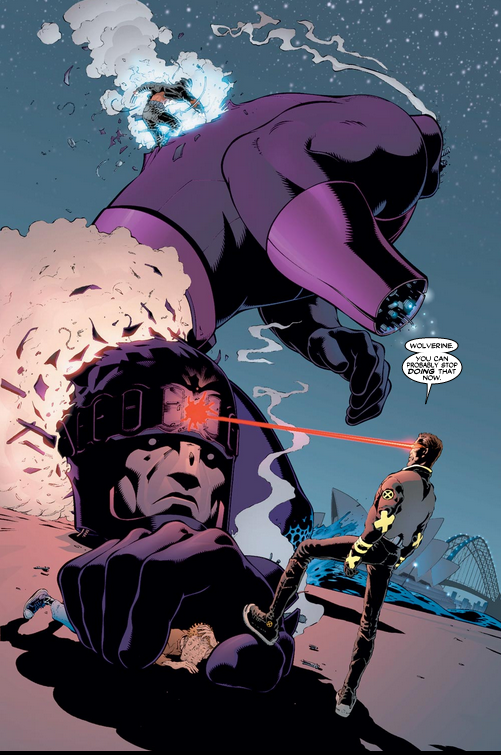
Here, the old-school Sentinel design – contrasted very deliberately with the designs Morrison would unleash later in this same arc – speaks of yesterday; Wolverine represents the fan who is content to fight the same old battles, unaware that the old and familiar world has died. Cyclops, in contrast, stands bored, just going through the motions, fed up with it all and acting as the voice of reason. This, to Morrison, was the split in fandom.
Morrison’s solution was a simple one: he wanted to be radical. He took the helm of X-Men (rebranded as New X-Men), and penned 40 issues in which he revisited almost all the core concepts of the X-Men franchise, and dramatically reinterpreted them. Genosha, the Sentinels, the Shi’ar, the Phoenix, Weapon X, and of course Magneto – all these were radically transformed by Morrison. Again, to quote Morrison:
“My intention is to use the rich history of the X-MEN more as background window dressing and as a treasure trove of material we can recut for a new eager audience (in the same way Claremont and Byrne sifted out the best stuff from the original series and combined it with new material). Elements like the Savage Land or the Shi’Ar Empire will be reappraised, reintroduced and woven into the larger scale science fiction universe of the X-MEN in such a way that it will seem as though we’re seeing these concepts for the first time.”
Needless to say, such an approach divides fans. Morrison felt free to rewrite continuity to suit his own ends, and in some cases – such as in his interpretation of Emma Frost – he felt free to ignore entire previous runs, ignoring most character development (and almost all information about her origin) in Generation X. To this day, some fans love these comics; others hate them.
Supporting Morrison’s work, Marvel arranged for Frank Quitley to redesign the X-Men into clothes that spoke less of super-heroes and more of teamwork. Interestingly enough, Marvel had been working on such a redesign anyway – Project Rooftop has some examples of redesigns commissioned just before Morrison from Alex Ross – and so they had no issues with this.
As I run through this (in?)famous series, I’m both going to give a quick run-through and then examine how the Morrison era reshapes the Marvel Universe’s wider continuity.
TIMELINE
Morrison jumps straight in with change; Beast is mutating, and the team are donning new, Frank Quitely-designed uniforms. We’re halfway through New X-Men #114 before Morrison even troubles to mention that the X-Men are sporting a new look.

His stories run in the following arcs:
- ‘E is for Extinction’ (New X-Men #114-116); this arc introduced Morrison’s new villain Cassandra Nova, and began the Morrison run with the dramatic destruction of Genosha, with the island nation of mutants levelled by an army of Sentinels. In reaction, Professor Xavier goes public about being a mutant and about the school. The story culminates with the revelation that Cassandra Nova now possesses Charles Xavier’s body, even as ‘Charles’ heads to the Shi’Ar Empire for ‘relaxation’.
- ‘The Man From Room X’ (New X-Men Annual), introduced the characters of Xorn and John Sublime.
- ‘Imperial’ (New X-Men #118-126) introduces the villain John Sublime. Cassandra Nova escalates her battle against the X-Men, leading the Shi’Ar Empire into all-out attack on the Mansion.
- ‘New Worlds’ (New X-Men #127-133) sees Charles Xavier rise to the challenge of growing anti-mutant sentiment, forming the X-Corporation. In a series of haunting and evocative adventures, Morrison introduces us to Fantomex and reveals that Polaris survived the destruction of Genosha. The Shi’Ar break off all ties with the X-Men.
- ‘Riot at Xavier’s’ (New X-Men #135-138) tells the story of renegade (and all-too-powerful) Quentin Quire, who leads unrest at the Mansion.
- ‘Murder at the Mansion’ (New X-Men #139-141) is essentially a ‘whodunnit’ starring Bishop, who investigates an attempted assassination of Emma Frost.
- ‘Assault on Weapon Plus’ (New X-Men #142-145) focuses in on the secrets of Weapon Plus, with Cyclops and Wolverine allying with Fantomex.
- ‘Planet X’ (New X-Men #146-150) reveals the true identity of Xorn – Magneto, who starts a holocaust in New York all of his own. Jean is killed, and the saga ends with Wolverine stabbing Magneto, killing him outright.
- ‘Here Comes Tomorrow’ (New X-Men #151-154) is the final Morrison arc, revealing a dystopian future that can only be averted if Cyclops chooses to live on after Jean’s death, and embrace his future with Emma Frost.
CHARACTERISATION
Each week, I’m going to focus in on just a handful of characters who saw particular development in the run I’m looking at.
Cyclops
Morrison built upon the idea that Cyclops had just returned from a dark trauma – possession by Apocalypse in The Twelve. Apocalypse’s presence, we are told, confronted Cyclops with a lot of the lies and illusions he’d believed about himself; and so he becomes much more bad-@$$ than ever before, right down to killing a mutant to put him out of his misery in New X-Men #115.
In many ways, Cyclops is at the centre of the story Morrison is telling. The first X-Man, he represents the X-Men more than anyone else; in Scott’s case, holding on to the stale past (his marriage to Jean) but desiring the wild, unpredictable future (Emma Frost). The psychic affair, while among the most controversial X-Men plotlines ever written, is almost a written metaphor that represents Morrison’s perception of the X-Men comics franchise. It’s no coincidence that the story in which he must choose to stay with the X-Men and with Emma is entitled ‘Here Comes Tomorrow’; and the fact that Jean blesses their relationship is meant as a kind of ‘moving on’.
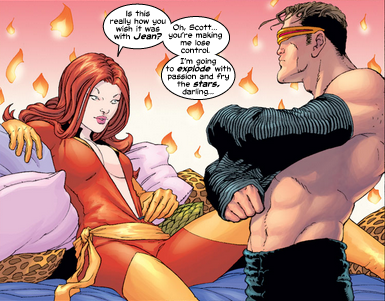
Although cool, it has to be said that this characterisation and imagery is frankly rather weird.
Jean Grey
Morrison drew the relationship between Jean Grey and the Phoenix closer than it had ever been drawn before, essentially transforming Jean into something infinitely beyond mutant. Because of this, Morrison saw Jean as a figure who sometimes forgot to be human, and there’s nothing more chilling than the ease with which she forces Emma Frost to confront her past. It’s like the act of a judgmental god, and Jean happily declares that the Phoenix is a purifying fire – again, powerful Old Testament imagery of judgment.
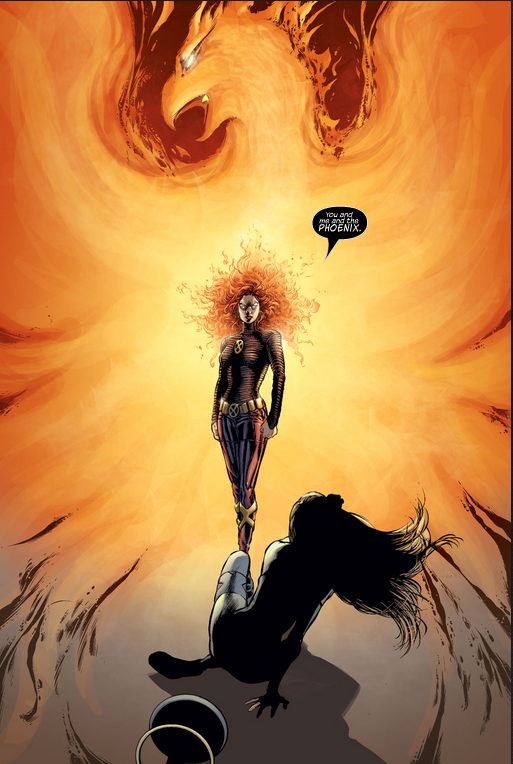
Emma Frost
Curiously enough, Emma Frost wound up used in New X-Men almost by accident. Morrison had intended to use Colossus, but Piotr had just died in Dream’s End, and he was opposed to the ‘revolving door’ approach the X-titles had taken to death. As Morrison started working on the X-Men comics, though, a fan posted an online comment:
“I’ve been ******* myself wondering if you’ll be using Emma (White Queen) Frost during your run.
Since GenX is being cancelled, we’ve got this horribly powerful telepathic leather fetishist Daddy’s (poor little rich) girl who straddles the fence between right and wrong just lying around, begging for a certain Scottish genius writer to snatch her up. Please make my day and tell me you’ve got big plans for her.”
Morrison’s response?
“I had no plans at all for Emma Frost but now that you mention it, man…”
That being said, Morrison completely rewrote Emma Frost’s origins, ignoring Generation X #24 and Generation X #-1. He tells a story of Emma, no longer as the Dominatrix, but as a stubborn girl who used her sex appeal and telepathy to manipulate men around her. Morrison’s perspective on the character would be reinforced in the Deadly Genesis arc and the Emma Frost series.
Beast
Morrison has great fun with Beast. Hank McCoy has mutated (again), and his initial joy turns to sorrow as the cost of it all begins to accumulate. Beast, more than almost all the other characters, is faced with the subtle prejudices of the world around him. Right down to long-term girlfriend Trish Tilby splitting up with him when the tabloid ‘bestiality’ puns on their relationship get too much for her.
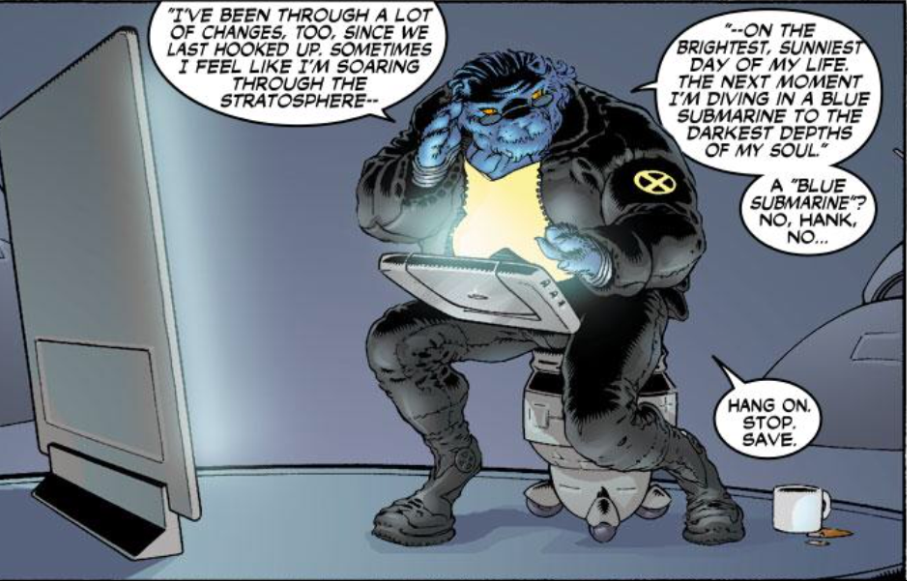
Magneto
Of course, this is where the controversy blazes. Morrison saw Magneto as representing an old, out-dated ideology, one soaked in blood and justified only by violence. When Magneto enters the scene, all subtlety and refinement of the Claremont era is gone; Magneto is very much the mustachio-twirling villain of the Stan Lee days. Many fans react with outrage, not least influenced by Sir Ian McKellen’s presentation of the character in the movies.
To Morrison, Magneto represents all that is tired and old about the X-Men; and so it is that Magneto is killed by Wolverine, just as he was at the end of the Lobdell run.
Marvel did not approve of this take on Magneto, and retconned it within a month.
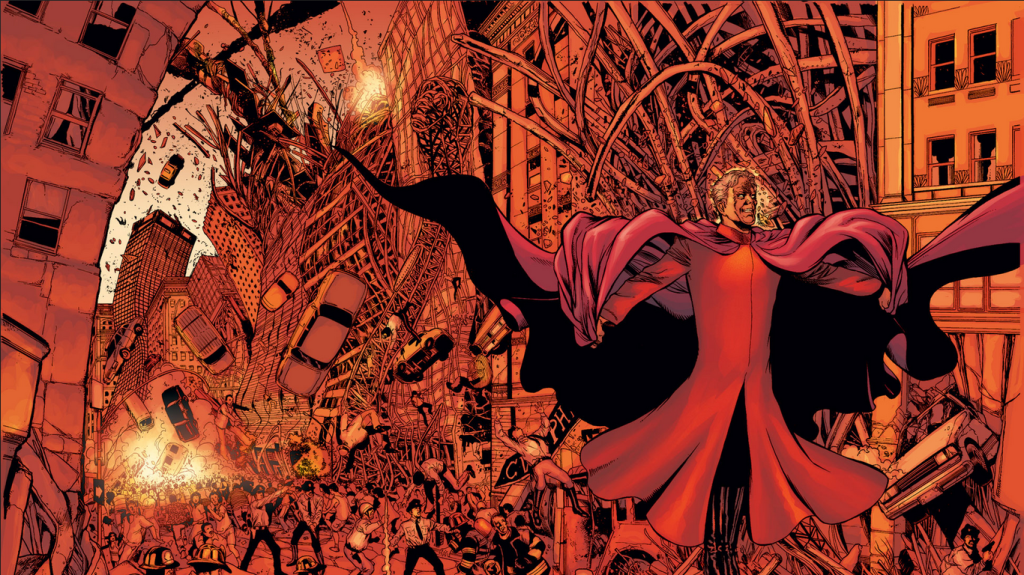
Of course, Morrison created a whole treasure-trove of new characters – the Stepford Cuckoos, who have consistently played a key role in the next generation of X-Men; Quentin Quire, brought back into the limelight by Jason Aaron in ‘Schism’; and, of course, Fantomex, who remains heavily active in the pages of ‘X-Force’.
CONTINUITY
Oddly enough, the most enduring aspect of the Morrison era’s legacy is the most subtle; where the X-Men had previously been concerned with integration, Morrison’s comics foresaw a future where the mutant race had rendered the human race extinct. In many ways, everything that followed – from ‘House of M’to ‘Utopia’ to ‘AvX’ – assumed that Morrison’s reinterpretation here is right.
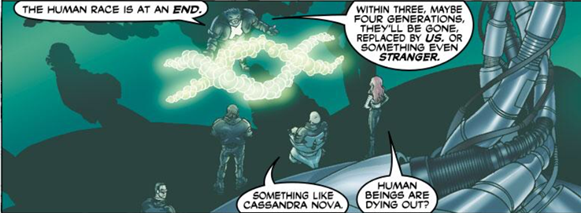
Another lasting concept, although rarely used, is that of secondary mutations; that at some point a mutant can develop an additional mutation, whether it be a new feline look for the Beast or Emma Frost’s developing the power to turn to diamond. The concept was most recently used by Jason Aaron to explain Husk’s mood-swings in his Wolverine & the X-Men.
Morrison placed only the loosest of interests in continuity, as was exemplified by his use of Sentinels in ‘E is for Extinction’. For Trask-era Sentinels to be quite so adaptive as that plotline shows is hard to believe (especially given we saw how that era of Sentinels would respond to the idea of Sentinel adaptability and mutation in Avengers #102-105, see below for the panel from Avengers #105).
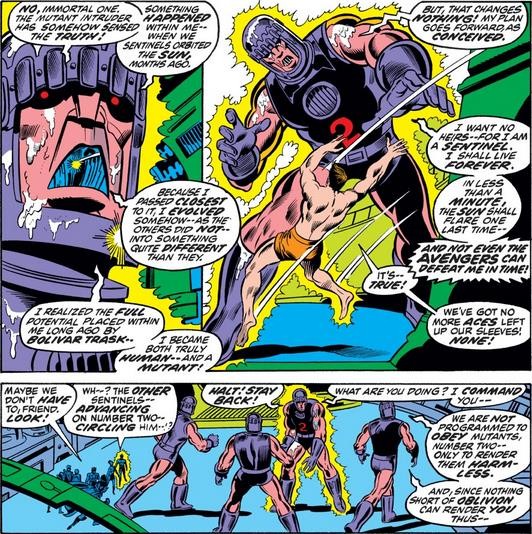
Perhaps the most fascinating touch was Morrison’s classy reinterpretation of Weapon X – the ‘X’ didn’t stand for the ‘unknown’. It was the Roman numeral X. This retcon was superb, tying Wolverine into the broader Marvel Universe – with Captain America being Weapon I – and leading to the creation of the character Fantomex. Morrison also used this to introduce the concept of The World, which would become a major element of the ongoing X-Men universe.
Of course, not all Morrison’s reinterpretations were liked. Marvel looked at what Morrison had done with Magneto, and realised they would have a difficult job ever using the character again. So, they had Chris Claremont rewrite this in Excalibur #1. In reality, the Magneto in the Morrison run had been a fake, the being known as Xorn. The various Xorns have an established place in X-lore now, right down to a future Xorn being part of the Battle of the Atom storyline.
CONCLUSION
In many ways, the Morrison Era lays the foundations for everything the X-Men became in the next decade. So many elements have been abandoned – the X-Corporation did not survive the Decimation, and the Magneto plotline was summarily abandoned by Marvel within a month of Morrison’s leaving the series.
That being said, the turbulent relationship between Cyclops and Emma would be critical to the X-Men up until AvX, his original characters such as Quentin Quire have been restored by an era of writers who grew up reading and loving Morrison’s run, and his Weapon Plus concept serves as a neat bridge between Wolverine and the broader Marvel Universe. The X-Men franchise is still building on Morrison’s foundations, perhaps more than ever before.


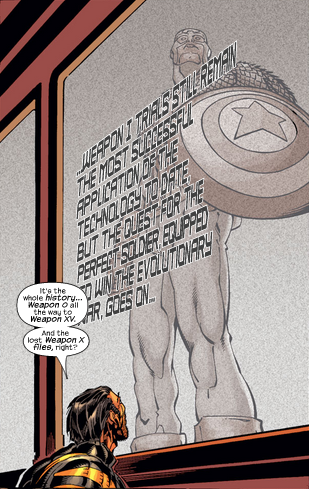
Weapon X – Weapon 10 and Captain America Weapon I real trash!